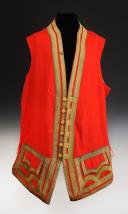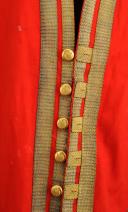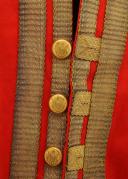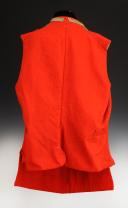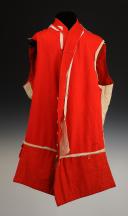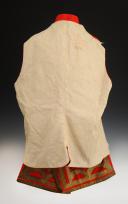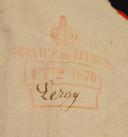
GRAND UNIFORM VEST OF THE EMPEROR'S STABLE SERVICE, Second Empire. 32141
Sold out
GRAND UNIFORM VEST FROM THE EMPEROR'S STABLE SERVICE, Second Empire. 32141
In scarlet cloth, entirely bordered with a double gold braid, outer braid width 1.8 cm, inner braid width 2.5 cm, closing straight at the front with six hooks in gilded brass. Front of the vest adorned with six small brass uniform buttons, Ø 1.8 cm, embossed with the Great Imperial Arms. At the lower part, false horizontal pockets entirely bordered in gold, back in fine scarlet canvas, lining in ivory canvas bearing the ink stamp "SERVICE DES ÉCURIES / 1Ttre 1870" surmounted by the imperial crown, and below the date inscribed in pen "Le Roy".
France.
Second Empire.
Very good condition, some moth holes, missing back belt loop.
HISTORY: The Emperor's house brings together the officers, servants, and civilian staff serving the private and domestic needs of Emperor Napoleon I. A symbol of his independence and assurance of power, it organizes the court's daily life around him in the palaces and during the reign's major events, ensures compliance with etiquette, and manages the Crown's domain. A true "State within the State," it will constitute around Napoleon, throughout his reign, a final golden wall, even in 1814 when the marshals and ministers falter. It is inspired by the King's house that existed under the Ancien Régime until 1792. Thus, Napoleon recreates the pages' house, the great almonry, and the hunt, quintessentially monarchic activities that add splendor to his reign, even though by his own admission, he had no interest in religion and no talent for hunting.
THE STABLES The service of the grand equerry, General Armand de Caulaincourt, includes a first equerry, General Nansouty, a grand officer of cavalry of the First Empire, and about ten equerries. Between 1807 and 1811, when Caulaincourt was appointed the Emperor's ambassador to Russia, it was Nansouty who daily assumed the duties of grand equerry. The grand equerry is responsible for the sovereign's schedule, organizing his travels and security on both journeys and in field bivouacs. Apart from lodging and meals, everything related to the Emperor's travels falls under his authority. He designates the men, carriages, and horses, notably. Like the grand marshal of the palace, the grand equerry permanently accompanies Napoleon. He guards the Emperor's weapons, follows him closely on foot or horseback, and helps him over steep passages. He assists the Emperor in mounting his horse and hands him his whip and reins. If his mount falls, he helps it up; if it is killed, he gives him his own. The grand equerry commands the stables of Saint-Cloud and oversees the messengers, estafettes, and dispatches of the Emperor's household. He also supervises the education of the thirty pages assigned to the Emperor's service, surrounded by a governor and teachers.
THE IMPERIAL EQUESTRIAN CARRIAGES UNDER NAPOLEON III Text: by Mr. Henri Baup
When elected President of the Republic on December 12, 1848, Louis Napoleon Bonaparte became the Prince President, and four years later, the Second Empire was proclaimed, he would be called Napoleon III. When he came to power, he found, in the National Palace stables, at the Louvre, at the Trianon in Versailles, at the Tuileries, numerous service or grand gala carriages that had belonged to his predecessors (Napoleon I (1814); Louis XVIII (1815); Charles X (1824); Louis Philippe (1848)) and some of which were restored at great expense and used for exceptional occasions. Part of the service staff had remained in place after the departure of the former masters. Quickly, new carriages (especially berlines) and new harnesses necessary for the Court's service were ordered from the great Parisian carriage and saddlemakers: Ehrler, Brune, Roduwart (for the harness)... The task of reorganizing the stables and the carriage service was entrusted to the Grand Equerry, General Count Emile Fleury, who was joined by one of his former ordnance officers, General Baron Faverot de Kerbrech, himself assisted by the head groom Henri Thuillier, who throughout the Second Empire remained in charge of the team service, organizing the composition, choosing horses, carriages, and harness according to the rules of French service or in d'Aumont that he had learned in the king's service Louis Philippe and Charles X. Very quickly, under the impulse of these men of art, the Imperial Stables gained a universal reputation for perfection and supreme elegance. It will later be said that the Second Empire was truly the golden age of luxury horse carriages.
...
THE END OF THE IMPERIAL STABLES
In 1881, as President of the Council, Gambetta created a Ministry of Fine Arts for his friend Antonin Proust, which would be installed at the Louvre. To create offices, it was decided to free up the stables. The Empress then had to take back the carriages and harnesses belonging to her and had them brought to Farnborough Hill (Hampshire), where she lived in seclusion, the grand gala carriage with seven mirrors and an eight-horse harness. Two public auctions of a number of carriages were made (we will report on them later); the grand gala carriages remained at Trianon.
The golden age of large luxury carriages was over.
In scarlet cloth, entirely bordered with a double gold braid, outer braid width 1.8 cm, inner braid width 2.5 cm, closing straight at the front with six hooks in gilded brass. Front of the vest adorned with six small brass uniform buttons, Ø 1.8 cm, embossed with the Great Imperial Arms. At the lower part, false horizontal pockets entirely bordered in gold, back in fine scarlet canvas, lining in ivory canvas bearing the ink stamp "SERVICE DES ÉCURIES / 1Ttre 1870" surmounted by the imperial crown, and below the date inscribed in pen "Le Roy".
France.
Second Empire.
Very good condition, some moth holes, missing back belt loop.
HISTORY: The Emperor's house brings together the officers, servants, and civilian staff serving the private and domestic needs of Emperor Napoleon I. A symbol of his independence and assurance of power, it organizes the court's daily life around him in the palaces and during the reign's major events, ensures compliance with etiquette, and manages the Crown's domain. A true "State within the State," it will constitute around Napoleon, throughout his reign, a final golden wall, even in 1814 when the marshals and ministers falter. It is inspired by the King's house that existed under the Ancien Régime until 1792. Thus, Napoleon recreates the pages' house, the great almonry, and the hunt, quintessentially monarchic activities that add splendor to his reign, even though by his own admission, he had no interest in religion and no talent for hunting.
THE STABLES The service of the grand equerry, General Armand de Caulaincourt, includes a first equerry, General Nansouty, a grand officer of cavalry of the First Empire, and about ten equerries. Between 1807 and 1811, when Caulaincourt was appointed the Emperor's ambassador to Russia, it was Nansouty who daily assumed the duties of grand equerry. The grand equerry is responsible for the sovereign's schedule, organizing his travels and security on both journeys and in field bivouacs. Apart from lodging and meals, everything related to the Emperor's travels falls under his authority. He designates the men, carriages, and horses, notably. Like the grand marshal of the palace, the grand equerry permanently accompanies Napoleon. He guards the Emperor's weapons, follows him closely on foot or horseback, and helps him over steep passages. He assists the Emperor in mounting his horse and hands him his whip and reins. If his mount falls, he helps it up; if it is killed, he gives him his own. The grand equerry commands the stables of Saint-Cloud and oversees the messengers, estafettes, and dispatches of the Emperor's household. He also supervises the education of the thirty pages assigned to the Emperor's service, surrounded by a governor and teachers.
THE IMPERIAL EQUESTRIAN CARRIAGES UNDER NAPOLEON III Text: by Mr. Henri Baup
When elected President of the Republic on December 12, 1848, Louis Napoleon Bonaparte became the Prince President, and four years later, the Second Empire was proclaimed, he would be called Napoleon III. When he came to power, he found, in the National Palace stables, at the Louvre, at the Trianon in Versailles, at the Tuileries, numerous service or grand gala carriages that had belonged to his predecessors (Napoleon I (1814); Louis XVIII (1815); Charles X (1824); Louis Philippe (1848)) and some of which were restored at great expense and used for exceptional occasions. Part of the service staff had remained in place after the departure of the former masters. Quickly, new carriages (especially berlines) and new harnesses necessary for the Court's service were ordered from the great Parisian carriage and saddlemakers: Ehrler, Brune, Roduwart (for the harness)... The task of reorganizing the stables and the carriage service was entrusted to the Grand Equerry, General Count Emile Fleury, who was joined by one of his former ordnance officers, General Baron Faverot de Kerbrech, himself assisted by the head groom Henri Thuillier, who throughout the Second Empire remained in charge of the team service, organizing the composition, choosing horses, carriages, and harness according to the rules of French service or in d'Aumont that he had learned in the king's service Louis Philippe and Charles X. Very quickly, under the impulse of these men of art, the Imperial Stables gained a universal reputation for perfection and supreme elegance. It will later be said that the Second Empire was truly the golden age of luxury horse carriages.
...
THE END OF THE IMPERIAL STABLES
In 1881, as President of the Council, Gambetta created a Ministry of Fine Arts for his friend Antonin Proust, which would be installed at the Louvre. To create offices, it was decided to free up the stables. The Empress then had to take back the carriages and harnesses belonging to her and had them brought to Farnborough Hill (Hampshire), where she lived in seclusion, the grand gala carriage with seven mirrors and an eight-horse harness. Two public auctions of a number of carriages were made (we will report on them later); the grand gala carriages remained at Trianon.
The golden age of large luxury carriages was over.
Reference :
32141
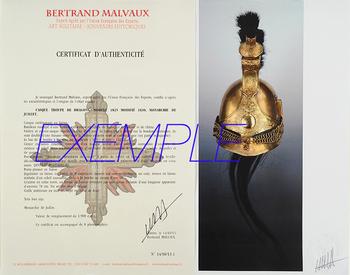
Next update Friday, december 26 at 13:30 PM
FOR ALL PURCHASES, PAYMENT IN MULTIPLE CHECKS POSSIBLE
bertrand.malvaux@wanadoo.fr 06 07 75 74 63
SHIPPING COSTS
Shipping costs are calculated only once per order for one or more items, all shipments are sent via registered mail, as this is the only way to have proof of dispatch and receipt.
For parcels whose value cannot be insured by the Post, shipments are entrusted to DHL or Fedex with real value insured, the service is of high quality but the cost is higher.
RETURN POLICY
Items can be returned within 8 days of receipt. They must be returned by registered mail at the sender's expense, in their original packaging, and in their original condition.
AUTHENTICITY
The selection of items offered on this site allows me to guarantee the authenticity of each piece described here, all items offered are guaranteed to be period and authentic, unless otherwise noted or restricted in the description.
An authenticity certificate of the item including the description published on the site, the period, the sale price, accompanied by one or more color photographs is automatically provided for any item priced over 130 euros. Below this price, each certificate is charged 5 euros.
Only items sold by me are subject to an authenticity certificate, I do not provide any expert reports for items sold by third parties (colleagues or collectors).
FOR ALL PURCHASES, PAYMENT IN MULTIPLE CHECKS POSSIBLE
bertrand.malvaux@wanadoo.fr 06 07 75 74 63
An authenticity certificate of the item including the description published on the site, the period, the sale price, accompanied by one or more color photographs is automatically provided for any item priced over 130 euros. Below this price, each certificate is charged 5 euros.
Only items sold by me are subject to an authenticity certificate, I do not provide any expert reports for items sold by third parties (colleagues or collectors).
